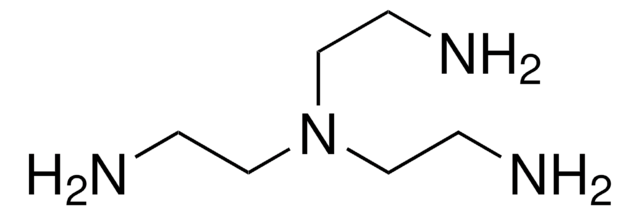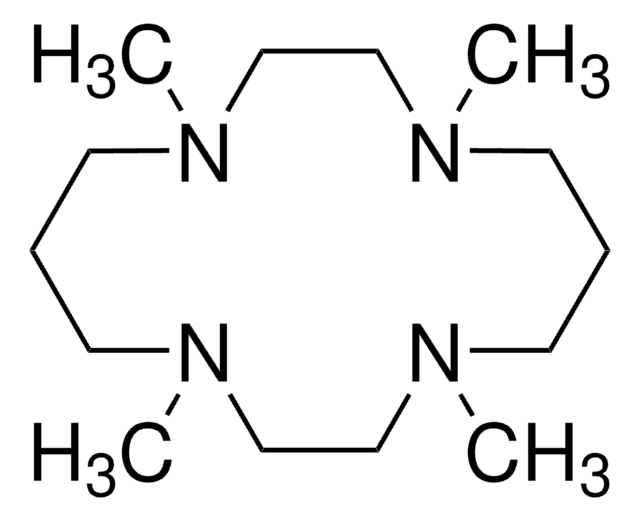369497
N,N,N′,N′′,N′′-Pentamethyldiethylenetriamine
99%
Sinónimos:
PMDETA, PMDTA
About This Item
Productos recomendados
presión de vapor
0.23 mmHg ( 20 °C)
Nivel de calidad
Análisis
99%
formulario
liquid
temp. de autoignición
311 °F
lim. expl.
5.6 %
índice de refracción
n20/D 1.442 (lit.)
bp
198 °C (lit.)
mp
−20 °C (lit.)
densidad
0.83 g/mL at 25 °C (lit.)
cadena SMILES
CN(C)CCN(C)CCN(C)C
InChI
1S/C9H23N3/c1-10(2)6-8-12(5)9-7-11(3)4/h6-9H2,1-5H3
Clave InChI
UKODFQOELJFMII-UHFFFAOYSA-N
¿Está buscando productos similares? Visita Guía de comparación de productos
Descripción general
Aplicación
- A catalyst in the synthesis of multifunctional silicone acrylate prepolymers for use in UV-curable coatings.
- A multifunctional initiating and cross-linking agent in the synthesis of polyacrylamide hydrogels. It improves the mechanical properties of the hydrogels, such as toughness and resilience, without compromising their biocompatibility.
- An organocatalyst in ring-opening polymerization (ROP) of trimethylene carbonate. This catalyst can be easily removed after the reaction compared to metal catalysts.
- A catalyst along with CuBr to synthesize a series of side-chain azobenzene poly(meth)acrylates via the atom transfer radical polymerization(ATRP) technique.
- An initiator to grow polystyrene chains to prepare polyolefin-polystyrene copolymers.
Palabra de señalización
Danger
Frases de peligro
Clasificaciones de peligro
Acute Tox. 3 Dermal - Acute Tox. 4 Oral - Eye Dam. 1 - Skin Corr. 1B
Código de clase de almacenamiento
6.1A - Combustible acute toxic Cat. 1 and 2 / very toxic hazardous materials
Clase de riesgo para el agua (WGK)
WGK 2
Punto de inflamabilidad (°F)
168.8 °F - closed cup
Punto de inflamabilidad (°C)
76 °C - closed cup
Equipo de protección personal
Faceshields, Gloves, Goggles, type ABEK (EN14387) respirator filter
Elija entre una de las versiones más recientes:
¿Ya tiene este producto?
Encuentre la documentación para los productos que ha comprado recientemente en la Biblioteca de documentos.
Los clientes también vieron
Artículos
Tools and techniques for performing atom transfer radical polymerization (ATRP) with benefits and limitations.
Atom transfer radical polymerization (ATRP) has emerged as one of the most successful synthetic techniques for the preparation of polymers with predetermined molecular weights, narrow molecular weight distributions, and high degrees of chain end functionalities.
ATRP polymerization, chain transfer agent, living polymerization, functional telechelic polymers
Find how atom transfer radical polymerization (ATRP) tools can be used for the synthesis of well-defined functionalized polymers.
Protocolos
We presents an article featuring procedures that describe polymerization of methyl methacrylate and vinyl acetate homopolymers and a block copolymer as performed by researchers at CSIRO.
Sigma-Aldrich presents an article about RAFT, or Reversible Addition/Fragmentation Chain Transfer, which is a form of living radical polymerization.
Sigma-Aldrich presents an article about the typical procedures for polymerizing via ATRP, which demonstrates that in the following two procedures describe two ATRP polymerization reactions as performed by Prof. Dave Hadddleton′s research group at the University of Warwick.
Nuestro equipo de científicos tiene experiencia en todas las áreas de investigación: Ciencias de la vida, Ciencia de los materiales, Síntesis química, Cromatografía, Analítica y muchas otras.
Póngase en contacto con el Servicio técnico![Tris[2-(dimethylamino)ethyl]amine 97%](/deepweb/assets/sigmaaldrich/product/structures/695/792/ee0ff167-22a3-43a7-83a1-6c4908adf0ae/640/ee0ff167-22a3-43a7-83a1-6c4908adf0ae.png)
![Bis[2-(N,N-dimethylamino)ethyl] ether 97%](/deepweb/assets/sigmaaldrich/product/structures/372/323/505a46ae-b067-4177-8e5f-19a3f4ef9c44/640/505a46ae-b067-4177-8e5f-19a3f4ef9c44.png)













